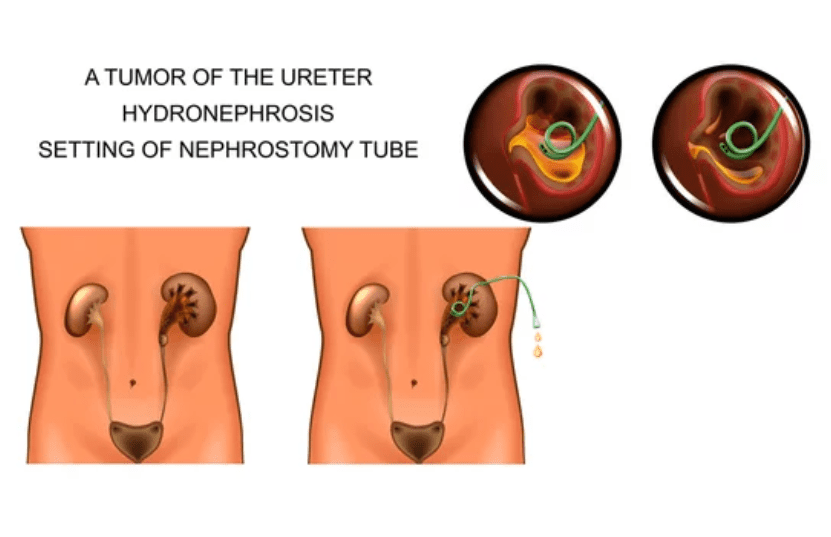Explore our ‘Complete Guide to Nephrostomy Tube Care,’ a comprehensive resource providing essential tips and advice on maintaining a nephrostomy tube. Learn about hygiene practices, signs of complications, and the importance of regular check-ups to ensure optimal kidney health and patient comfort. Navigate your nephrostomy journey with confidence and ease.
Introduction to Nephrostomy Tube Care
A nephrostomy tube is a thin, flexible tube that is inserted through your skin and into your kidney. It helps drain urine from your kidney if you have a blockage in your urinary tract. A nephrostomy tube can also be used to deliver medicines or fluids to your kidney.
This guide will help you learn how to care for your nephrostomy tube at home. You must keep the tube and the skin around it clean and dry, check for signs of infection or leakage, and empty and measure the urine in the drainage bag. You must also know when to call your doctor or nurse for any problems or questions.
Caring for your nephrostomy tube is essential for your health and comfort. Follow the instructions and tips in this guide and ask your healthcare team if you need more information or support.
Importance of Proper Nephrostomy Tube Care
Proper nephrostomy tube care is essential to prevent complications such as infection, bleeding, leakage, or tube dislodgement. Some of the steps to take care of the nephrostomy tube are:
- Wash your hands before and after touching the tube or dressing.
- Keep the skin around the tube clean and dry. Change the dressing as instructed by your healthcare provider.
- Check the tube for kinks, cracks, or signs of blockage. Ensure the tube is securely taped to your skin and connected to a drainage bag.
- Empty the drainage bag when it is half full or at least every 8 hours. Measure and record the amount of urine drained each time. Report any changes in color, odor, or consistency of the urine to your healthcare provider.
- Flush the tube with sterile saline solution as your health care provider instructed. This can help prevent clogging of the tube.
- Avoid pulling or twisting the tube. Do not let anyone step on or pull on the tube or drainage bag.
- Avoid activities that may cause trauma to the tube or kidney, such as contact sports, heavy lifting, or bending.
- Follow a healthy diet and drink plenty of fluids to clear your urine and prevent kidney stones.
A nephrostomy tube is a temporary solution to drain urine from the kidney. Your healthcare provider will monitor your condition and determine when it is safe to remove the tube.
Follow your healthcare provider’s instructions on how to prepare for and recover from the removal procedure. If you have any questions or concerns about your nephrostomy tube, do not hesitate to contact your healthcare provider.
Tools Needed for Nephrostomy Tube Care
You will need some tools and supplies to care for your nephrostomy tube at home.
The tools you will need are:
- A pair of scissors
- A measuring cup or graduated cylinder
- A syringe
- A clamp
- A drainage bag
- A dressing kit
The supplies you will need are:
- Sterile water or saline solution
- Alcohol wipes
- Gauze pads
- Tape
- Gloves
You will also need a clean and dry place to store your tools and supplies, such as a plastic container with a lid. You should wash your hands before and after handling your nephrostomy tube and any tools or supplies.
You should also follow the instructions given by your doctor or nurse on how often to change your dressing, flush your tube, empty your drainage bag, and check for signs of infection or leakage.
Step-by-Step Guide for Cleaning a Nephrostomy Tube
- Start by washing your hands thoroughly and putting on sterile gloves.
- Clean the skin around the tube with the prescribed cleaning solution, using a circular motion starting at the tube and moving outward.
- Dry the area with a clean towel and apply a fresh dressing.
- Secure the dressing with medical tape.
Tips for Changing the Dressing of a Nephrostomy Tube
Here are some tips for changing the dressing of a nephrostomy tube:
- Wash your hands with soap and water before and after changing the dressing.
- Gather all the necessary supplies, such as a new dressing, sterile gauze, tape, scissors, gloves, and a plastic bag.
- Remove the old dressing carefully and dispose of it in the plastic bag. Do not pull or tug on the tube.
- Check the skin around the tube for any signs of redness, swelling, pus, or bleeding. If you notice any of these, contact your doctor or nurse immediately.
- Clean the skin around the tube with sterile gauze soaked in warm water or saline solution. Gently pat it dry with another piece of gauze.
- Apply a new dressing over the tube and secure it with tape. Ensure the tape does not cover the holes at the end of the tube or interfere with the urine flow.
- Change the dressing at least once daily or more often if it becomes wet or dirty
- Follow any other instructions your doctor or nurse gave regarding the care of your nephrostomy tube and drainage bag.
How to Prevent Nephrostomy Tube Blockage
A nephrostomy tube requires meticulous care to prevent infection, leakage, or blockage.
Here are some tips on how to prevent nephrostomy tube blockage:
- Drink plenty of fluids unless your doctor tells you otherwise. Fluids help flush out your kidneys and prevent urine from becoming too concentrated or forming crystals that can clog the tube.
- Check your urine regularly for color, clarity, and amount. Your urine should be clear or pale yellow and free of blood or sediment. If you notice any changes in your urine, contact your doctor or nurse.
- Empty your drainage bag when it is half full or at least every 8 hours. Do not let the bag get too full; it may cause back pressure on your kidney and increase the risk of infection or blockage.
- Flush your nephrostomy tube as instructed by your doctor or nurse. Flushing helps remove debris or clots that may cause blockage in the tube. Depending on your situation, you may need to flush your tube once a day or more often.
- Keep your nephrostomy tube secure and free of kinks or twists. Use a dressing, tape, or a particular device to hold the tube in place and prevent it from pulling or moving. Avoid bending, twisting, or stretching the tube as this may cause damage or blockage.
- Change your dressing and clean your skin around the tube as your doctor or nurse instructed. A clean dressing and skin help prevent infection and irritation. Depending on your situation, you may need to change your dressing every day or every few days.
- Report any signs of infection, leakage, or blockage immediately to your doctor or nurse. Signs of infection include fever, chills, redness, swelling, pain, or pus around the tube site. Signs of leakage include wetness, odor, or staining around the dressing or on your clothes. Signs of blockage include decreased urine output, cloudy or bloody urine, pain in your kidney area, or swelling in your abdomen or leg.
A nephrostomy tube can help you manage a urinary blockage and improve your kidney function. Following these tips can prevent nephrostomy tube blockage and avoid complications.
Recognizing Signs of Infection
Some of the signs of infection are:
- Fever or chills
- Pain, redness, swelling, or drainage around the tube site
- Cloudy, bloody, or foul-smelling urine
- Burning or pain when urinating
- Increased frequency or urgency of urination
- Nausea or vomiting
- Back pain or flank pain
If you notice any of these signs of infection, you should immediately call your doctor or nurse. They may prescribe antibiotics or other treatments to clear the infection.
You should also follow the instructions on how to care for your nephrostomy tube and bag, such as keeping them clean and dry, changing them regularly, and flushing them with sterile water.
By following these steps, you can reduce the risk of infection and complications from your nephrostomy tube.
Common Complications and How to Avoid Them
A nephrostomy tube can help relieve pain and prevent damage to your kidney. However, it also has some common complications you should be aware of and try to avoid.
Some of these complications are:
- Infection: The tube can introduce bacteria into your kidney or skin, causing an infection. Signs of infection include fever, chills, redness, swelling, pain, or pus around the tube site. To prevent infection, keep the tube site clean and dry, change the dressing regularly, and wash your hands before and after touching the tube or bag. You should also take antibiotics as prescribed by your doctor.
- Bleeding: The tube can cause bleeding in your kidney or skin, especially when it is first inserted or removed. You may notice blood in your urine or on the dressing. To prevent bleeding, you should avoid pulling or twisting the tube and follow your doctor’s instructions on how to flush the tube with saline solution. You should also drink plenty of fluids to keep your urine clear and prevent clots from forming.
- Dislodgement: The tube can come out of your kidney or skin accidentally, causing urine leakage and possible infection or bleeding. To prevent dislodgement, you should secure the tube with tape or a particular device and avoid activities that may tug on the tube, such as bending, twisting, or lifting heavy objects. You should also check the tube regularly for signs of kinking or blockage and report any problems to your doctor.
- Kidney damage: The tube can damage your kidney over time, causing scarring, inflammation, or loss of function. This can happen if the tube is left in too long, if it is too large for your kidney, or if it causes repeated infections or bleeding. To prevent kidney damage, follow your doctor’s advice on how long you need the tube and when it should be removed or replaced. You should also have regular blood and imaging tests to monitor your kidney function and health.
A nephrostomy tube can be a lifesaving device for some people with urinary tract problems. However, it also carries some risks you should be aware of and try to avoid.
By following these tips and working closely with your doctor and nurse, you can reduce the chances of complications and improve your quality of life.
When to Contact Your Healthcare Provider
You must take care of your nephrostomy tube and drainage bag to prevent infection and other complications.
Some signs that you should contact your healthcare provider are:
- No urine drainage from the tube for more than 12 hours.
- The location of the black dot on the tube has changed.
- The clamp around the disk holding the tube is loose or opened.
- The suture that secures the tube is broken (if you have one).
- Your skin around the tube is red, irritated, swollen, or painful.
- You have a fever of 100.4°F (38°C) or higher.
- You have blood or pus in your urine.
- You have pain or discomfort in your kidney area or lower back.
- You have trouble urinating or feel the need to urinate often.
Call your healthcare provider immediately if you notice any of these signs. Do not try to fix the problem yourself. Follow the instructions given by your healthcare provider and keep your appointments for changing the tube every 2 to 3 months.
Conclusion
Concluding on nephrostomy tube care, the focus is on preventing infection and ensuring the system is functioning correctly. The nephrostomy bag attached to the catheter tube is key in this process. The bag collects urine produced by the kidneys, draining it directly from the kidney. The tube should always be connected, with only one tube per kidney to drain urine. The bag can be replaced with a new one as needed and should be kept lower than the waist to facilitate drainage.
While daily care instructions involve cleaning around the nephrostomy tube, replacing the gauze dressing, and ensuring the tube doesn’t leak, other safety measures should be observed. Cover the bag with plastic wrap during a shower to prevent urine leaks, let it air dry afterwards, and be sure to empty the drainage bag regularly.
Patients should watch closely for new or worse symptoms like blood in the urine, signs of a kidney infection, or if the tube leaks. Any of these signs should warrant immediate medical care. Kidney stones, scar tissue, or an issue with the ureter could lead to a blocked tube. In such cases, the interventional radiology department in a hospital can help.
The child’s doctor or a nurse will teach the caregiver how to replace and handle the nephrostomy bag and catheter, and follow-up care is crucial. Remember, caring for the nephrostomy tube is a key part of treatment, and it needs to be flushed and cleaned every day to prevent complications. Therefore, it is vital to be careful, follow all given directions, and ensure regular clinic visits for a check-up.
Finally, always ensure comfort and normalcy for the child. A careful balance of precautions and normal activities like walking, standing, and even swimming (provided the nephrostomy tube is properly protected) can be maintained. All this information means that the patient or caregiver is well equipped for nephrostomy tube care, thereby making an informed health decision.








